|
Printables |
PowerPoints |
Online exercises |
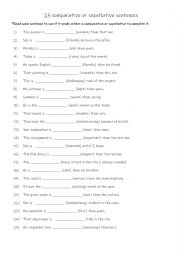
|
Comparative or superlative sentence practise 2 A
This worksheet is suitable for CEFR A2 level. Students read each sentence to see if it needs either a comparative or superlative to complete it. Answers on page 2. In worksheet 2 B there is a generic speaking reinforcement activity using 25 of the base form adjectives in this worksheet.
Level: elementary
Age: 9-100
Type:
Downloads: 118
|
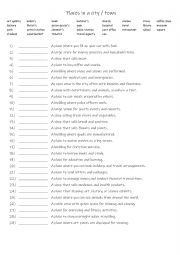
|
A1+-A2 27 places in a city or town
Students familiar themselves with the places in a town / city. Then they read the definitions and write the according place on the line provided. This worksheet could also be used as a speaking reinforcement activity for pairs and small groups- How often do you use this place ? What is the most important / best place that you use? Etc. Answers o...
Level: elementary
Age: 8-100
Type:
Downloads: 112
|
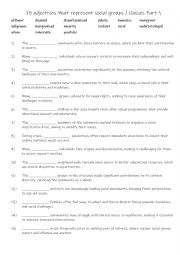
|
B2-C1 15 adjectives that represent social groups & classes Part 1
Adjectives that represent social groups or classes are essential for describing various sections of society. These adjectives highlight different social, economic, cultural, or demographic groups and help to frame discussions about social issues, policies, and dynamics in an informed way. These adjectives help you describe different social groups a...
Level: advanced
Age: 10-100
Type:
Downloads: 128
|
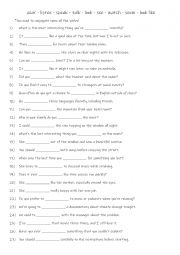
|
B1-B2 Confusing words Hear - listen - speak - talk - look - see - watch - seem - look like
Students familiarise themselves with the 10 verbs to see what is the difference in meaning. Then they read the sentences to see which verb is needed to complete the gap-fill. The students need to conjugate some of the verbs. Answers on page 2.
Level: intermediate
Age: 8-100
Type: worksheet
Downloads: 118
|
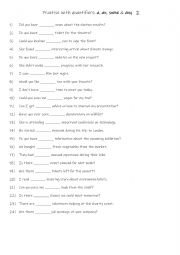
|
A1-A2 Practise with quantifiers a , an , some & any 2
Practising quantifiers such as a, an, some and any is crucial for helping students communicate effectively in English. These quantifiers are used to indicate amounts, differentiate between countable and uncountable nouns, and express affirmative, negative, or interrogative contexts. Understanding their proper usage not only enhances grammatical acc...
Level: elementary
Age: 8-100
Type:
Downloads: 104
|
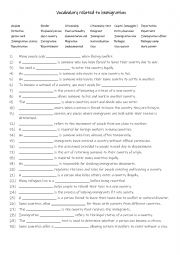
|
B1+-B2 Vocabulary related to immigration
Students familiarise themselves with the 30 words and their meanings, then they read the definitions to work out and write in the space provided which one is being described. Answers on page 2.
Level: intermediate
Age: 10-100
Type:
Downloads: 118
|
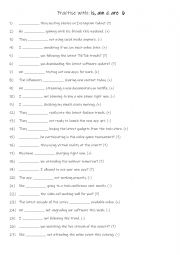
|
A1 Practise with is, am & are 6
Students read the sentence and complete the sentence with the correct form of the verb to be. They use the (+) or (-) sign at the end of the sentence to see if it needs a positive or negative form of the verb to be. Each form is used 3 times! Answers on page 2.
Level: elementary
Age: 7-100
Type:
Downloads: 134
|
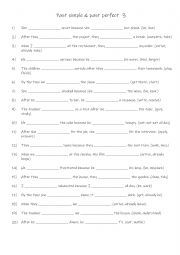
|
Past simple & past perfect 3
Learning the past simple and past perfect tenses is crucial for students as it helps them communicate clearly about past events, showing when actions occurred and how they relate to one another in time. Mastering these tenses improves storytelling, writing, and speaking, enabling students to convey events in a logical and nuanced way. Additionally,...
Level: elementary
Age: 9-100
Type:
Downloads: 109
|
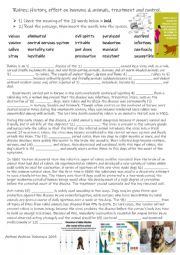
|
Rabies: History, effect on humans & animals, treatment and control.
550-Word reading article with a 20-word gap fill exercise about rabies. It takes an in-depth look at the history of the disease, the effect on humans, treatment and how it is being controlled.This sheet is suitable for higher level A2 to B1 students of all ages. An answer sheet is included. For higher level students they could be put in groups to g...
Level: elementary
Age: 12-100
Type: worksheet
Downloads: 1872
|
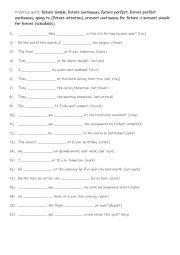
|
B1-B2 Future Simple, Future Continuous, Future Perfect, Future Perfect Continuous, Going to (Future Intention), Present Continuous for Future, Present Simple for Future (Schedules) 1
Learning the various future tenses in English (such as Future Simple, Future Continuous, Future Perfect, Future Perfect Continuous, "Going to," Present Continuous, and Present Simple) is important because each tense conveys a different aspect of future actions. These tenses help students to express predictions, plans, ongoing actions, completed act...
Level: intermediate
Age: 9-100
Type:
Downloads: 106
|
|
|
|
|












